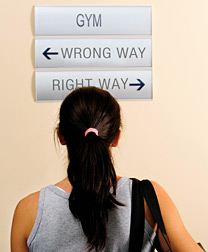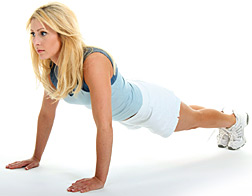The right way versus the wrong way to exercise; now this is a topic that needs to be discussed more often. Just the other day, a friend of mine told me she had injured her chest muscle while doing Pilates. Of course, her training was unsupervised; in her case, she was following along with a DVD. She went to the hospital and was diagnosed with a torn chest muscle. Who would think someone could seriously injure themselves by doing Pilates on a DVD? It happens more frequently than you think. And if you can hurt yourself doing Pilates, you can definitely hurt yourself while working out at the gym lifting weights or using any of the equipment.
It's a Question of Form
 All of my patients know I am a stickler for form. I don't care how much
weight you are lifting or how many times you can perform an exercise; if
your form is not correct, you need to reduce the amount of weight you
are using and/or slow down. I'm a stickler on form for two important
reasons:
All of my patients know I am a stickler for form. I don't care how much
weight you are lifting or how many times you can perform an exercise; if
your form is not correct, you need to reduce the amount of weight you
are using and/or slow down. I'm a stickler on form for two important
reasons:#1 Safety (Injury Prevention). Correct form is key when doing any exercise. In fact, it's the first thing you must master! If not, you will eventually injure yourself. If you aren't sure if you are doing something correctly, please get a competent professional to assist you.
#2 Effectiveness. If you want to get the most out of your workouts, you have to use correct form. There is a right way to exercise and a wrong way to exercise, and this applies to each and every exercise you perform. Exercising is an art form that takes years to master. But let's face it; the average person does not see it that way, and that is why so many injuries occur and/or motivation disappears.
Most people have no clue how to do a proper squat, push-up, lunge, leg press, chest press - you get the idea. Lack of proper form is the number-one cause of injuries. Most people in the gym look around for someone who has a body they want and then try to mimic the same exercises the person is doing. Sometimes the person they are looking to as an example does have the correct form, but that doesn't mean you can mimic it correctly. It may have taken them years to learn how to do it the right way. But most of the time, the person they are looking too as a model saw someone else do the exercise and they are doing it wrong as well. It's a vicious cycle.
Repetitions/Sets
The general rule for repetitions and sets is straightforward: If you are trying to gain muscle or get stronger, you want to do low reps and higher sets. For example, you may be doing a leg press and you are trying to get stronger (hypertrophy), so you put on a heavier weight and do 6-8 reps per set for 4-5 sets. On the other hand, if you are just trying to build endurance and lean out, then you should do higher reps and lower sets; typically 15-20 reps per set for 2-3 sets. Now there are some middle reps and sets as well, like 10-12 reps/5-6 sets, but these are the basic rep/sets. The point is, it's important to understand how different sets, reps and even the types of exercises you perform affect your body. Again, talking to an exercise specialist will help you determine the best way to achieve your fitness goals.
Right Way, Wrong Way: 9 Exercise Mistakes
- Lat pulldown. The wrong way: pulling bar behind neck can cause serious injury to the shoulder. The right way: Pulling bar down in front of you while squeezing your back muscles (the rhomboids and latisimus dorsi).
- Push-ups. The wrong way: You should never have a dip or
arch in your back or lock your arms. The right way: Arms should be
underneath you and not locked, back parallel to the floor. Engage your
"core" the entire time (squeeze your glutes and draw in your belly
button).
- Walking lunges. The wrong way: When performing a lunge,
extending the front knee past the front foot will cause injury at some
point. The right way: When you are in a split stance, go straight down
and do not let your front knee go past your foot.
- Leg press. The wrong way: Your knees should not be by your
ears; that is not a position your knees are used to being in, especially
under heavy weight. The right way: Keep 80 percent of the weight in
your heels; press out and go a little past 90 degrees.
- Abs (crunches). The wrong way: Pulling the head up as you're doing a crunch. The right way: Relax your head and bring your shoulders off the ground, engaging your abs and rotating your hips to the ground.
- Squats. The wrong way: Knees coming forward over your toes.
The right way: Perform this exercise as if you were sitting back on a
chair and putting 80 percent of your weight on your heels. Then lean
slightly forward so you won't fall back.
- Chest press. The wrong way: Lifting the weight using your
back (high arch). The right way: Keep your back flat and relax your
shoulders while lifting the weight.
- Cardio. This isn't really a specific exercise, but it still
is something that lots of people do wrong in the gym: doing an hour or
more of cardio. No, I'm not crazy; the only people who should do an hour
of cardio are marathon runners. If you aren't planning to be in a
marathon anytime soon, then I wouldn't do an hour. In fact, I recommend
high-intensity training - for example, a 30-second sprint or quick walk
followed by a 60-second jog, then another 30-second sprint, and so on;
repeat that cycle about 10-12 times and you will get way more out of your cardio workouts in half the time. It works, trust me. Try it!
- Frequency: Being too zealous and working out 6-7 days a week for an hour or more each time. Your body needs rest and repair after a workout, so pace yourself and make exercise a healthy habit, not an obsessive one. If you don't take this advice, you will start to develop chronic injuries or just get burned out and stop working out, which is not what your exercise program was designed to achieve.

And let's not forget about the right and wrong way to exercise in general. As I mentioned earlier, exercise is an art form and since most of us have not taken the time to master the proper techniques, we should get some expert advice prior to working out. Most gyms have personal trainers who will give you a free consultation and show you some basic machines and correct postures. Your doctor can also be a good source of information, particularly if they specialize in exercise and rehabilitation protocols. After all, you wouldn't just jump into a pool and expect to start swimming, right? Learn the right way to exercise from day one. When it comes to fitness goals, it isn't about how quickly you achieve them, because more often than not, going too quickly will end up being the slowest, most painful route. Exercise the right way, stay safe, and enjoy the journey.
4 Movements to Avoid When Exercising
- Using jerking motions, especially when lifting. Speed is fine when done appropriately, but you should always have fluid motion and proper form when performing any and all exercises; otherwise you could strain or even tear something.
- Using body parts not required for the exercise. Have you ever seen people doing biceps curls and rounding their shoulders or arching their backs? Those are just two of the big no-no's that can lead to injury.
- Locking out your knees or elbows. Never lock your joints when working out; keep them slightly bent so the weight will not be transferred to the joints.
- Arching your back. Picture someone on the barbell bench press, lifting a weight that is actually too heavy for them. Chances are that eventually, they will start arching their back. Sooner than later, that back is going to give out and they won't be able to exercise for days, weeks or even longer.
No comments:
Post a Comment